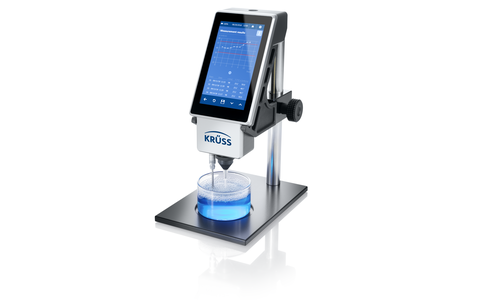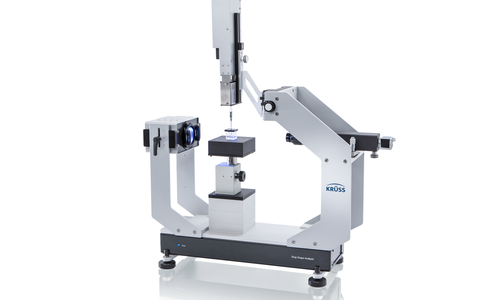
Characterization of surfactants
Advanced methods for the investigation of cleaning and wettings agents, emulsifiers, foamers, and more
Surfactants as wetting agents, emulsifiers, cleaners or foaming agents assume an important role in the mixing of liquids or when they come into contact with solid substances. Questions which require an analysis of the interface are associated with the development, optimization and correct dosing of surfactants. How well does the surfactant reduce the surface tension or interfacial tension? How quickly does it act? By how much does it improve wetting? Is there a tendency to foam, and what is the nature of any foam that is formed?
Our tensiometers measure the surface tension and therefore determine the effectiveness and efficiency of surfactants. They accurately measure the interfacial tension and thus help in the development and optimization of emulsions. Our dynamic tensiometers provide you with the know-how you need for using surfactants in fast processes. Analyses carried out with our contact angle measuring instruments give you reliable information on the degree of wetting. And our foam analysis instruments help you to optimize your foaming product or to prevent foam.
Measurement of surface tension
The surface tension is an important parameter for many tasks and processes, e.g.:
- Printing, coating, bonding
- Wetting during cleaning
- Galvanic baths
- Firefighting
- Plant protection
- Dispersion of powders and pigments, for example in suntan lotion, latex, concrete
Hydrophobic surfaces and particles are poorly wetted due to the high surface tension of water. Surfactants reduce the surface tension and in this way improve the wetting of solid surfaces and the dispersibility of powders.
Our tensiometers quantify the effect of the surfactant based on the precise, semi-automatic or fully automatic measurement of the surface tension. Optical pendant drop measurements with our drop shape analysis instruments enable the smallest sample volumes to be investigated.
Measurement of the critical micelle concentration (CMC)
Measurement of the CMC provides important information for the use of surfactants, e.g.:
- Efficiency with regard to the cleansing effect of surfactants
- Optimizing the dosage of wetting agents
The critical micelle concentration (CMC) is the concentration at which the surface is completely covered with surfactant molecules. Above this concentration, clusters of surfactant molecules, referred to as micelles, occur in the solution. Among other things, micelles are responsible for the cleansing effect of a surfactant, as they can incorporate and mobilize hydrophobic substances. Measuring the CMC enables the surfactant concentration at which the cleansing effect begins to be determined.
Above the CMC the surface tension does not reduce further when more surfactant is added. In the case of wetting agents, there is therefore no point in using a dosage above the CMC for cost reasons and ecological considerations. The dosage of a surfactant as a wetting agent can be optimized by measuring the CMC.
Our premium tensiometer measures the CMC fully automatically. The measurement can be carried out at constant volume with a very wide concentration range due to the interplay between dosing and extraction. As a result, the CMC is measured very precisely.
Measurement of the interfacial tension between liquids
Measurements of the interfacial tension are often carried out in the following fields and to answer the following questions:
- Emulsions for foodstuffs, cosmetics or medicines
- Ageing of hydrophobic liquids, e.g. transformer oil
- Microemulsions for tertiary oil recovery, solvent-free degreasing, bioavailability of hydrophobic pharmaceuticals
As emulsifiers, surfactants reduce the interfacial tension between phases which are not soluble in one another and therefore improve mixability. At the same time, they make it easier for small droplets to form and act to stabilize the emulsion, as they slow down or prevent the merging of droplets.
The interfacial tension of a liquid with respect to water is a measure of its hydrophobicity. Measurement of the interfacial tension is therefore used for ensuring the quality of liquids with which a phase mixture with water is undesirable. One example is the analysis of insulating transformer oils according to ASTM D-971.
Our tensiometers measure the interfacial tension between two liquids using the ring, plate, or rod method. Optical measurements can be carried out with our drop shape analysis instruments for small sample quantities.
Our spinning drop tensiometer is designed for very low interfacial tensions down to 10-6 mN/m, which occur, for example, in tertiary oil recovery (Enhanced Oil Recovery, EOR). These measurements help with the development and dosage of surfactant combinations for microemulsions.
Measurement of dynamic surface tension and interfacial tension
Dynamic surface tension or interfacial tension is important, for example, in the following applications of surfactants:
- Fast industrial wetting processes such as printing, painting, coating, bonding
- Atomizing capability and wetting when spraying
- Mixing of liquids for emulsification
- Checking of surfactant content in cleaning baths
Surfaces and interfaces are formed at high speed in various applications and production processes. However, surfactants need a certain amount of time for diffusion and adsorption. The surface tension and interfacial tension therefore depend on how much time has elapsed since a new phase boundary was formed. Accordingly, the interfacial tension or surface tension can be considerably higher with dynamic processes than in the steady state. This situation significantly affects the right choice and dosage of a surfactant. Our bubble pressure tensiometers measure the dynamic surface tension at surface ages of only a few milliseconds.
The bubble pressure method can also be used to determine the content of baths containing surfactants at concentrations above the CMC. In this range, the static surface tension is no longer dependent on the concentration. For testing, a reference curve can be produced with a stationary measuring instrument and then used for further tests on site with a mobile bubble pressure unit.
With dynamic liquid-liquid processes, such as emulsification for example, the time-dependent value of the interfacial tension is definitive. A drop volume tensiometer measure this dynamic value over a wide speed range. The result will help you to choose and correctly dose the right surfactant for optimizing your product or process.
Measurement of contact angle
Measurement of the contact angle is used to characterize surfactants to answer the following questions:
- The effect on wetting of adding surfactants
- Wettability of solids containing surfactants
The contact angle is an indication of the degree to which the wetting of a liquid is improved by the addition of a surfactant. Our drop shape analysis instruments measure the contact angle with a high degree of automation depending on the requirement. Measurements at high or low temperatures, controlled humidity or variable dosing dynamics flexibly simulate the conditions of your wetting process.
Solids are frequently blended with surfactants to improve the wettability by water. One example of this is the use of surfactants to promote and accelerate the dissolving of tablets. The change in contact angle with respect to time is particularly important for investigating the effect of the surfactant. This time-dependency reflects the speed with which surfactants adsorb at the interface with the liquid and act to improve solubility.
Foam analysis
Foam analyses are relevant in the following sectors for the optimization of foam formation and stability and for preventing foaming:
- Deliberate foam formation: Body care, culinary foams, flotation, firefighting
- Foam prevention: Printing and coating, cooling lubricants, liquid conveying, industrial cleaning
Surfactants frequently form foam and are often specifically used to produce foam. Particular areas of application lead to different requirements for foamability, foam stability, moisture content and the size of bubbles in the foam. Our foam analysis instruments use reproducible foam formation techniques and methods for measuring the foam height with respect to time. The moisture content of the foam and the change in height over a period of time at different heights in a foam column can be measured with our conductivity module. The optical foam structure analysis module determines the bubble size distribution and its time-dependency in order to specifically optimize the nature of the foam.
The foaming of surfactants frequently has undesirable effects on processes and product quality. Low-foaming surfactants are often used and foam-inhibiting substances added in order to prevent foaming. The quickly collapsing foam formed from such mixtures can be reliably analyzed in order to optimize foam prevention.
Surface rheological investigations
Surface rheological investigations increase your depth of knowledge of surfactants in the following areas:
- Mobility of surfactants
- Film stability
- Foam stability
- Emulsion stability
Surface rheology investigates the change in surface tension or interfacial tension as a function of speed, and the degree of change of the interface area. Our surface rheology instruments measure such quantities as the interface elasticity (storage modulus) and the interface viscosity (loss modulus). These quantities enable conclusions to be drawn relating to the mobility of surfactants and the stability of liquid films as well as droplets in emulsions. The results can also frequently be correlated with foam parameters such as drainage rate and foam bubble stability.
An awareness of the interface rheology increases the depth of knowledge of the behavior of surfactants in emulsions and foams. This can then contribute towards the optimization of products and processes in which surfactants play a part.













